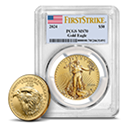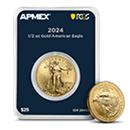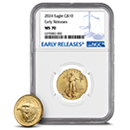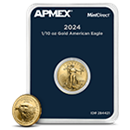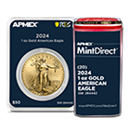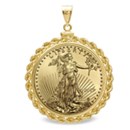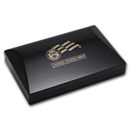American Gold Eagle Coins (All)

The American Gold Eagle
The American Gold Eagle is 22-karat gold, comprising 91.67% fine gold, 3% silver and 5.33% copper. These coins bear a distinctive hue and boast a slightly larger diameter and weight than .999 fine gold bullion counterparts. This unique alloyed composition imbues the coins with a nuanced color and ensures enhanced durability, setting them apart in the bullion world. The 1 oz American Gold Eagle has an actual weight of 33.93 grams or 1.0909 troy ounces, containing a full troy ounce of pure gold.
The deliberate alloy blend not only differentiates it in appearance but also provides a larger canvas for the design of Liberty on the obverse and a bald eagle on the reverse. Each 1 oz coin has a diameter of 32.7mm and a thickness of 2.87mm.
Beyond its aesthetic appeal and intrinsic value, the American Gold Eagle is a tangible representation of American ideals and a prudent choice for investors seeking bullion-backed security in their portfolios. As a flagship gold coin of the United States Mint, the American Gold Eagle continues to captivate collectors and investors, embodying the nation's legacy of excellence and enduring value.
For investors seeking to diversify their precious metals portfolio, the American Silver Eagle series is a perfect complement to Gold Eagles.
American Gold Eagle Fractional Sizes
Unlike some gold bullion coins, the American Gold Eagle offers fractional sizes, providing options in 1/2, 1/4, and 1/10 troy ounces. This diversity of sizes provides an advantage to enthusiasts and investors, permitting the acquisition and liquidation of gold in smaller, more manageable increments.
Gold Eagle fractional sizes were included within the legislation that birthed the American Eagle Program. This allowed for the creation of sizes beyond the standard one troy ounce, catering to a diverse range of investors and collectors. Since fractional sizes are less expensive than the 1 oz Gold Eagle, people with a smaller budget have a chance to own gold.
Fractional Gold Eagle Mintage
Fractional Gold Eagles typically have lower mintages compared to their full troy ounce counterparts. In 2022, the U.S. Mint produced 850,000 1 oz Gold Eagles and only 75,000 ½ oz, 140,000 ¼ oz, and 575,000 1/10 oz sizes. While this is a common ratio of mintages, there are numerous years (1995, 1996, 1999-2002, 2006, 2007, 2014-2019) in which there were more 1/10 oz Gold Eagles produced than the popular 1 oz option. In 1999, there were 2,750,338 1/10 oz and 1,505,026 1 oz minted. The smallest Gold Eagle caters to a large niche market that wants a cheaper gold bullion option.
Fractional Gold Eagle Premiums
Fractional Gold Eagles typically carry higher premiums per unit. While the lower mintage plays a small factor in the higher premiums, it is mainly because it costs more to produce smaller sizes. While an average 1 oz Gold Eagle might carry a premium around 5-7%, fractional sizes have higher premiums that increase as a percentage as the size decreases. The ¼ oz has higher premiums than the ½ oz, but has a lower premium than the 1/10 oz Gold Eagle. The affordability and lower barrier to entry make up for the higher premiums.
Fractional Gold Eagle Products
Fractional Gold Eagles are available in various forms, including certified coins, burnished coins, and proofs. Certified fractional Gold Eagles have been graded by reputable grading services to authenticate their quality and condition.
Fractional Burnished Gold Eagles were minted in 2006-2008, before burnished finishes were halted in 2008. When the U.S. Mint began producing burnished Gold Eagles again, they were only minted in the 1 oz version, a practice that continues today.
Proof finishes of fractional Gold Eagles are also available in every size, although they were not minted until 1988. In 1986, no fractional sizes were minted with a proof finish, and in 1987 only the ½ oz Gold Eagle was given a proof version alongside the 1 oz size.
Additionally, there are special sets, such as fractional Gold Eagle sets containing each denomination, and special anniversary editions, commemorating significant years of the coin's production.
Fractional sizes are unique since not all gold coins are available in smaller denominations. While numerous other gold coins have been released in fractional sizes, including the Canadian Maple Leaf and South African Krugerrand, the Gold Eagle is the only current bullion coin produced by the U.S. Mint in fractional sizes.
Gold Eagle Release Schedule
The release schedule of the American Gold Eagles follows a similar pattern each year, typically commencing with pre-release sales for the upcoming year around October. Though not an absolute guarantee, this structured timeline offers a degree of predictability compared to some other coin releases. With every new release the supply of available Gold Eagles in the market surges. This supply and demand imbalance can create opportunities for retail investors to buy and sell Gold Eagles, sometimes at a discount.
Simultaneously, this annual cycle triggers a common trend within the numismatic (coin collecting) industry. Older mintages transition into a state of scarcity as newer coins enter circulation, propelling their value. One example lies in the appreciation of the 2022 American Gold Eagles by approximately 3% over their 2023 counterparts as 2023 draws to a close with the pre-release of 2024 widely available. This phenomenon underscores the inherent collectability of these bullion coins, with enthusiasts avidly assembling collections by year. Since each year of the Gold Eagle has a limited mintage and older years will never be minted again, collectors are willing to pay higher premiums to complete collections before the release of a new year. The growing scarcity of specific dates fuels heightened demand, amplifying the allure and value of years that are exiting production.
Gold Eagle Premiums
The premiums between Gold Eagle bullion coins and Gold Eagle collectible versions like proofs, certified, and burnished coins can vary significantly. Bullion coins typically carry lower premiums over the current spot price of gold, making them a popular choice for investors primarily seeking gold's intrinsic value.
On the other hand, collectible versions often command higher premiums due to their limited mintage, superior quality, and aesthetic appeal. Proofs, certified, and burnished coins, crafted with precision and often boasting exceptional finishes fetch higher prices in the market. While all gold coins and bars have a premium, the premium on collectible gold is slightly different than the premiums on bullion. Collectible (or numismatic) gold has a premium that’s based partially on the rarity and popularity of the year and type of coin. A certified gold eagle in a difficult to find year can fetch premiums that are multiples higher than gold bullion. Retail investors are willing to pay more for certified gold when building collections or speculating on a particular year and mintage.
American Gold Eagles often carry slightly higher premiums than some other popular gold bullion coins like the Gold Brittania or Canadian Maple Leafs. These premiums can fluctuate based on various factors such as demand, mintage, and market conditions.
Although they carry a slightly higher premiums than some other gold coins, there are advantages to buying Gold Eagles. One advantage is the ability to include Gold Eagles in a precious metals IRA. They meet the IRS requirements to be included in an IRA, although there are certain conditions that must be followed. We recommend consulting with a professional if this is an investment strategy you wish you pursue. There may also be some tax advantages to a Gold Eagle that bullion from foreign mints may not have, and we encourage our customers to consult with their accountants if this is of interest.
Gold Eagle Collections
Building a collection of American Gold Eagles has several advantages for collectors and investors. Assembling a complete collection establishes a cohesive narrative, providing a deeper understanding of the coin's journey over time and its cultural context within American history.
From an investment perspective, collecting each year's American Gold Eagles can yield value appreciation, especially for older or scarcer editions, as they become more sought after due to their limited availability.
In November 2023, a coin collection containing forty 1/10 oz Gold Eagles from 1986-2023 was sold for $10,199. The collection consisted of 4 total troy ounces and was sold for approximately 27% over the current spot price, a significant return on investment. Considering the individual collecting gold coins was purchasing 1/10 ounce gold eagles when they could be acquired for less than $70 each, his return on investment was likely phenomenal.
Another collection of each size (1 oz, ½ oz, ¼ oz, 1/10 oz) 1997 Proof Gold Eagles sold for $5,600, approximately 47% over spot for the 1.85 troy ounces of gold. These examples illustrate how building a collection of American Gold Eagles can yield great returns.
The perceived value of American Gold Eagles, backed by their historical significance, recognizable design, and widespread global acceptance, often justifies the slightly higher premiums among investors and collectors seeking a balance between collectability and gold's intrinsic value. Ultimately, the premiums among these coins can vary based on individual preferences, market conditions, and each coin's specific attributes and appeal within the realm of precious metals investment.
Gold Eagles vs Gold Buffalos
When comparing Gold Eagles and Gold Buffalos originating from the esteemed U.S. Mint, there are a few obvious differences and a few not-so-obvious differences.
The largest difference is in fractional gold offerings. While Gold Eagles boast a range of fractional sizes, including 1/10, 1/4, and 1/2 troy ounce coins, Buffalos, apart from a limited production in 2008, circulate in the standard one troy ounce denomination. Although the general public has asked for more fractional buffalos to be produced, the time and expense for creating fractional gold buffalo coins is too great for the mint to pursue. Fractional gold investors will be limited to the Gold Eagle for the foreseeable future when purchasing from the US Mint. Fractional buffalos often sell for exorbitant premiums when they become available as they are very rare.
Another difference between eagles and buffalos is the mintage. Gold Buffalos are generally produced in smaller quantities compared to Gold Eagles. In 2023, there were 857,500 1 oz Gold Eagles and only 360,000 Gold Buffalos minted. Limited production boosts the sense of exclusivity and rarity associated with Buffalos, potentially raising their long-term value.
Examining the aesthetic and technical facets reveals further disparities. The Gold Eagle, with its alloyed composition of 91.67% gold, bears a slightly different color and has a higher weight due to its mix of metals. Conversely, the Gold Buffalo, crafted from .9999 fine gold, boasts unparalleled purity in U.S. bullion coins.
Gold Eagles and Gold Buffalos have certified options from the major third-party grading services. Proof versions of the buffalo have been produced every year since their initial release (2006), although a reverse proof was only minted in 2013. Burnished Gold Buffalos were minted in 2008 alongside fractional options but were discontinued and have not been produced since.
While both coins stand as hallmark offerings from the U.S. Mint, the choice between Gold Eagles and Gold Buffalos often hinges on individual preferences regarding fractional options, exclusivity, composition, and aesthetic appeal.
Proof Gold Eagles
Proof Gold Eagle coins go through a specialized minting process to create a coin with mirrored surfaces absent on regular coin releases. To make a proof coin, mint workers start with specially treated coin blanks that have been polished to a smooth, mirror-like finish. These blanks are then fed into presses fitted with polished dies that have been given a matte treatment to provide a frosted, sandblasted look. When the blank is struck by the dies under tons of pressure, the mirror-like blank takes on an impression of the frosted dies, resulting in a coin with incredible detail contrasted against mirrored fields.
Proofs also get struck twice to sharpen details. Ordinary coins, in contrast, are produced using dies with standard finishes that impart no special effects. The coins are struck only once each, resulting in a more pronounced, casual look compared to proof releases' sharper, more elegant appearance. Proof coins also receive special handling and packaging for collectors.
Proof coins attract people for their detailed presentation, limited production, and immaculate finish, going beyond their bullion value. Produced in limited mintages at only a percentage of the bullion releases, the scarcity of proof coins increases their collectable value. Additionally, proof sets are available for a steep premium that contain all four Gold Eagle sizes in every year except 2009 when the U.S. Mint suspended production of proof gold coins in order to keep up with the demand for bullion. Fractional proofs and proof collections expand the variety and appeal of these collectibles, offering diverse options for enthusiasts and investors.
Certified Gold Eagles
Certified Gold Eagles have been examined and graded by a third-party coin grading service. There are a few reputable entities like CAC (Certified Acceptance Corporation), PCGS (Professional Coin Grading Service), and NGC (Numismatic Guaranty Corporation) that certify coins. Each brings its standards and expertise, ensuring the authenticity and quality of these coins. Additionally, each third-party company gives certain coins unique designations to indicate their release schedule from the U.S. Mint. These designations add another layer of distinction that makes Certified Gold Eagles more valuable and desirable than their bullion counterparts.
PCGS Certified Gold Eagles
PCGS, known as the Professional Coin Grading Service, holds a strong reputation for excellence in numismatics. This third-party coin grading service sets a high standard for evaluating and certifying coin authenticity and condition, instilling trust and confidence in collectors and investors. PCGS encapsulation preserves the coin's condition and offers solid assurance about its authenticity and grade, enhancing the investment's credibility and attractiveness in the market. Certification provides a clear understanding of a coin's value, resolving historical challenges in determining worth. This accessibility appeals to a broader spectrum of investors seeking transparency and certainty in their coin investments.
PCGS gives coins a First Day of Issue designation when shipped from the U.S. Mint on the first day of release. FirstStrike® is given to Gold Eagles shipped within the first thirty days. These coins are believed to be some of the earliest minted and sent for grading, indicating proximity to the initial production and higher quality due to minimal handling. Collectors tend to favor coins labeled with First Day of Issue or FirstStrike®, finding them more attractive.
NGC Certified Gold Eagles
NGC, Numismatic Guaranty Company, is a distinguished coin grading and authentication authority. Investing in an NGC-graded American Gold Eagle coin means securing a piece of American history with a certified guarantee of authenticity and condition. NGC employs a team of skilled experts who diligently evaluate each coin. The encapsulation process ensures the preservation of your Gold Eagle coin, protecting it from environmental factors and maintaining its grade over time.
First Day of Issue designation from NGC means these coins were shipped from the U.S. Mint on the first day of the coins’ launch. NGC gives coins shipped within the first thirty days an Early Release designation. These coins are considered to be among the first struck and received for grading, suggesting they are closer to the initial production run and may have better quality due to less handling. Coins with a First Day of Issue or Early Release designations are more desirable for collectors.
UCAM and DCAM
Ultra Cameo (UCAM) and Deep Cameo (DCAM) coins are another step up regarding proof of Gold Eagles. While regular proof coins exhibit a frosted or cameo effect, UCAM and DCAM coins take the cameo effect to the extreme, showing an exceptional contrast between the frosted raised design and the deeply-mirrored, reflective background. These coins have striking visual appeal due to the high contrast, potentially fetching even higher premiums. UCAM and DCAM differ based on which third-party grading service issued the certification. PCGS certifies coins with the naming convention DCAM, and NGC uses UCAM. There is no physical difference between the two apart from nomenclature and it is solely a naming difference determined by the grading services. Investors should feel comfortable knowing that DCAM and UCAM coins are identical and only the labeling is different.
CAC Certified Gold Eagles
The Certified Acceptance Corporation (CAC) was created in 2007 to improve the coin grading standard. The CAC's first intention was to distinguish the difference in quality between previously certified coins of the same grade. If a coin meets the high-quality standard the company has established, it supplements the certification with its respected CAC sticker.
Starting in 2023, the CAC made the initial certification of coins rather than upgrading those already certified. Choosing a Gold American Eagle certified by CAC ensures it is graded to their rigorous standards for quality. CAC-approved coins frequently bring a premium to their non-approved counterparts. Because of their reputation, CAC-graded American Gold Eagles offer unique value to collectors.
CAC designations include First Day of Delivery and First Delivery. Certified Gold Eagles with the First Day of Delivery are coins shipped from the U.S. Mint on the first day of launch. Coins designated First Delivery were sent from the mint within the first thirty days of release.
Grading American Gold Eagles
Grading plays a pivotal role in determining a coin's quality. The grading scale ranges from MS-1 to MS-70, with MS-70 representing a perfect, flawless coin. MS-70 Gold Eagles exhibit no blemishes, and MS-69 coins stand just a notch below, exhibiting minor imperfections under close scrutiny. These imperfections are limited to hairline scratches or other miniscule marks and might be hard to discern for the untrained eye. The distinction between these grades might seem minute, but it holds considerable weight in the collector's world. A coin's grade significantly impacts its value and desirability among collectors, with MS-70 coins commanding a higher premium due to their pristine condition. The numismatic value of an MS-70 coin could potentially appreciate over time, as the population of these coins decreases due to mishandling or other unforeseen circumstances.
In essence, Certified Gold Eagles' value extends beyond their gold content. Their certified status and designated grades authenticate their legitimacy and denote their condition and rarity.
Burnished Gold Eagles
A Burnished Gold Eagle is a version of the American Gold Eagle coin series that undergoes a specialized minting process to achieve a distinct finish. These coins are struck on specially treated planchets using a coining process that involves polishing the blanks before striking them multiple times with specially polished dies. This process results in a coin with a smooth, matte-like finish.
Investing in Burnished Gold Eagles often stems from their unique blend of characteristics. Burnished Gold Eagles have a refined and polished appearance, catering to collectors and investors who appreciate the craftsmanship and exclusivity of numismatic coins. Additionally, their limited mintages add an element of rarity and collectability, attracting enthusiasts looking for coins with a unique appeal and potential for appreciation over time. First minted in 2006, burnished Gold Eagles were available in all four sizes until production halted in 2008. The U.S. Mint restarted production of the burnished Gold Eagles in 2011, but only for the 1 oz size and with scarce mintages of less than 10,000 coins each year.
Type 1 and Type 2 Gold Eagles
The creation of the American Gold Eagle traces back to the Gold Bullion Coin Act of 1985. The act was a response to the banishment of South African Krugerrands after President Ronald Reagan ended imports of the popular bullion coin due to the country’s racial policies. The United States was a lucrative market for the Krugerrand, and ending imports was meant to punish the apartheid government of South Africa.
Without the import of Krugerrands, the American market developed a vacuum for a gold bullion coin, making it harder for American investors to buy gold and paving the way for the introduction of the American Gold Eagles. Interestingly, the Gold Krugerrands and American Gold Eagles share similar dimensions, metal content, and weight, allowing the latter to fill the void left by the Krugerrand.
Authorized by the Gold Bullion Coin Act of 1985, the U.S. Mint first minted the American Gold Eagle in 1986. Its design pays homage to the nation's rich heritage, with the obverse featuring Augustus Saint-Gaudens' iconic depiction of Lady Liberty striding forward, torch in hand, radiating confidence and promise. This design was initially used on the American Double Eagle in 1907 after Theodore Roosevelt asked Saint-Gaudens to improve the beauty of American coins.
In 2021, the U.S. Mint changed the American Gold Eagle reverse design, marking a significant milestone governed by legislation that allows a new design once every 25 years. The transition from the original design, often termed "Type 1," to the newly introduced design, "Type 2," added a layer of historical context and collectability.
In the original Type 1 design, a male eagle was depicted in flight, carrying an olive branch while landing in a nest with a female eagle and hatchlings. The updated Type 2 design showcases a more intricately detailed depiction of the eagle. The modifications aimed to present a more lifelike and dynamic portrayal of the national symbol, enhancing the coin's aesthetic appeal while preserving its intrinsic value and historical significance.
Learn More About Precious Metals
Buying Precious Metals doesn’t have to be intimidating. Whether you are making a long-term investment or simply admire the beauty of Precious Metals, APMEX provides the tools to help you make the best choice for your portfolio.
See All Articles
